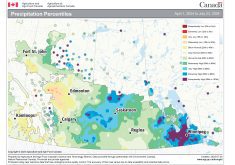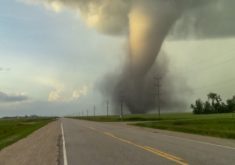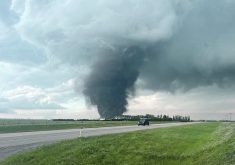The twister hit June 30 as residents prepared for Dominion Day, killing 28, injuring 300 and damaging many buildings
The Regina Cyclone remains the worst tornado in Canadian history, 111 years after it occurred.
On June 30, 1912, an F4 twister killed 28 people, injured 300 and caused $12,000 in property damage ($30.5 million today) and left 2,500 people homeless.
Called a cyclone back then, today it’s classified as a tornado. Cyclone is the generic term for any rotating air moving toward a low-pressure centre. A tornado is a cyclonic circulation of restricted size.
In 1912, Regina’s population of 30,000 prepared for the coming Dominion Day celebrations, now called Canada Day, by hanging 1,000 flags in the streets and planning special activities.
Read Also

Canola oil transloading facility opens
DP World just opened its new canola oil transload facility at the Port of Vancouver. It can ship one million tonnes of the commodity per year.
June 30 was a Sunday. Many went to church that morning and passed the afternoon trying to keep cool.
At 4 p.m., Mayor Peter McAra was touring a group of dignitaries from the Grand Trunk Railway around town. It was about this time the temperature dropped quickly and clouds formed in the south.
With no air conditioning, people sought ways to escape the heat — lounging in the shade of trees, going to the park or swimming in Wascana Creek.
Those lucky enough to have a house cooler than outside stayed indoors. Everyone welcomed the sight of clouds, hoping for a cooling shower.
The clouds are described as “a colour darker than the ace of spades”. No one imagined what lay ahead.
At 4:50 p.m., the twister touched down 18 kilometres south of town. The farm of Thomas Beares was the first to be hit. It was destroyed but fortunately, no one was injured.
The second farm to be touched was that of Walter Stephenson, who also lost everything without injury.
Next, the John Dunlop farm was demolished.
On the Roger Kerr farm, family members sustained injuries and sadly their guest, Andrew Roy, died.
The storm continued into town. Just before 5 p.m. the Power House whistle blew as a warning to citizens but the storm moved so fast that it had already passed the Power House, taking a path north through town. It cut a swath through homes and businesses 12 km long and 150 metres wide. Its velocity is estimated at 400 km-h. Another document described it as three blocks wide and nine blocks long.
“If the tornado had continued on its original path, it would have moved towards Winnipeg Street, an area that had few homes,” historian Craig Baird said.
“Instead, it moved to the north, heading straight towards downtown.”
Its path careened through the centre of town across Wascana Lake between the Power House and the new Legislature building, opened just seven years earlier. The Legislature was barely touched, having only a few windows broken. Passing over Wascana Lake, the tornado created a giant waterspout that demolished the Boat House with its swimming houses and boats, killing Vincent Smith and Phillis Steele.
Roaring down Smith Street, homes on the west side of the street were untouched, even leaving potted plants standing on verandas. On the east side, houses were completely demolished.
The Beelby family, at 2354 Smith Street, sought safety in their attic. The tornado tore off the attic and carried it and its occupants more than 150 metres, placing it in a neighbour’s yard with the family unharmed.
At Hodson’s home, 1947 Smith Street, one wall of the home collapsed, killing one child and three roomers. Another tenant, Arther Donaldson, was out walking his dog. Racing toward the house, the tornado killed Donaldson as it demolished the house and carried the dog away, which survived and was later returned.
Frank and Bertha Blenkhorn felt fortunate in April when they married in England and booked passage on the Titanic for later that same day. Their wedding party lasted so long they missed the sailing. Taking another boat, they started a new life in Regina.
As they walked across Victoria Park on June 30, the Regina Cyclone picked them up and deposited their lifeless bodies between the demolished Methodist parsonage and the now roofless Carnegie Library, newly built that spring.
The Telephone Exchange Building on the corner of Lorne and Eleventh Avenue lost its roof first before the south wall collapsed, which then allowed the switchboard to sink through from the second floor to the basement, carrying with it three women and one man. All received only minor injuries.
Moving north, the storm killed eight people on College Avenue. It then hit the Canadian Pacific Railway round house, stripping it of all but its frame, tipping over four elevators and tossing railway cars around like toys.
A brick warehouse disappeared. Five more people lost their lives there. Fred Berkon was knocked unconscious until after the storm passed but awoke on a pile of timber, relatively uninjured.
Hugh MacKinnon ran upstairs in his home to close a window against the approaching storm. The window blew out and he was carried to the end of the block. He recovered, stood up and looked down the street to his house, now having lost its roof and all windows. The windows blowing out relieved the pressure inside the house, preventing it from exploding, which was the fate of many homes. His family first sought refuge by the bay window and then went to the basement where they survived unhurt.
Now the tornado left the city. Arthur Martin and helper Henry Hollerbaum were living in a caboose while they worked in a field north of Regina. The wind rocked the caboose so violently, a heater came loose and chased the men around their small shelter while the storm passed, but they survived.
Their neighbours, Adolph and Louise, lost their barn roof, and pieces of wood flew around the yard. One large piece jammed against the door of the house. If the wood had entered the house, it probably would have killed the three children sheltering on the other side of the wall.
Henry Hollerbaum and his wife were living in a granary temporarily that summer. When the storm hit, his wife ran to save the baby who was sleeping in the granary and another bin blew against the door, trapping mother and child for hours.
The storm blew through Regina in less than six minutes. The deluge that followed the tornado fell for half an hour, dumping an inch of rain. The downpour prevented fire from causing further damage.
Peculiar events common to tornados also occurred. Mayor McAra was one of several who, an hour after showing the delegates around town, stood watching the tornado move through town in relative safety, the wind was that isolated. People outside the affected area watched, bewildered by what they saw.
As the twister passed the Legislature building, it sucked all the examination papers for all Saskatchewan schools out of the vacant windows. That year, teachers passed or failed their students based only on their year’s work.
At 5 p.m. the Winnipeg Telegraph Office received a message, “Cyclone hits Regina. City in ruins.”
Alerted from Winnipeg, the first help to arrive was a relief train to the Exhibition Grounds from Moose Jaw at 7:15 p.m. loaded with doctors, nurses and medical supplies. Another relief train arrived early the next morning from Winnipeg.
Regina isn’t remembered for its generosity to citizens. The homeless were charged for the nightly use of cots set up in school gyms and parks and for the cleanup of rubble at homes and businesses. However, relief came in a variety of forms, including financial donations from many sources, and everyone who was able pitched in.
An American theatrical troupe was performing in Regina at the time. When the tornado ripped through the city, the troupe was having a picnic on Wascana Creek and was completely unaware that anything had happened until they returned in the evening. They presented a benefit performance of the comedy The Real Thing. A week later while performing in Saskatoon, they donated half of their proceeds to the victims. The troupe included Boris Karloff, who later became famous for his portrayal of Frankenstein in the movie Frankenstein’s Monster.
By July 3, the entire city had been searched. By July 4, the railway was fully operational and an emergency phone had been set up at what was the old phone house. Regina received support from all over Canada.
Regina Realtors formed on July 10 to deal with the restoration of destroyed property and the resulting real estate boom.
Donaldson’s dog followed the rescuers as they took his master’s body to the funeral home, hung around until he saw him buried and then disappeared.
In 1912, my grandfather, Wilbur McLean, was a young, single man just starting a new life as a carpenter in Regina, having arrived from Nova Scotia. He was one of those who helped the Telephone Exchange staff escape out a basement window. The rescued survivors then went to the local newspaper office to tell their story but the newspaper’s staff didn’t believe them, thinking they only wanted their names printed in the paper.
It took Regina two years to repair all the damage, 10 years to repay the storm debt and 40 years to repay loans taken to rebuild.
















